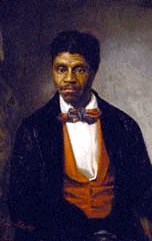|
~ US Supreme Court ~
Scott then appealed to the U.S. Supreme Court. The
court heard his case, formally known as Scott v. Sandford, in
the spring of 1856 but did not decide it that year. Instead,
the court ordered new arguments, to be conducted in December
1856, after the upcoming presidential election. Montgomery Blair,
who would later serve as postmaster general in the Cabinet of
President Abraham Lincoln, and George T. Curtis, brother of Supreme
Court Justice Benjamin R. Curtis, represented Scott for free.
U.S. Senator Henry S. Geyer of Missouri, and Reverdy Johnson,
a Maryland politician and close friend of Chief Justice Taney,
represented Scott's owner. In March 1857 the court ruled in a
7 to 2 decision that Scott was still a slave and therefore not
entitled to sue in court. For the first time in history, each
of the nine justices on the court wrote an opinion in the same
case, explaining their various positions on the court's decision.
Chief Justice Taney's 54-page majority opinion of
the court had wide-ranging effects. In it he argued that free
blacks-even those who could vote in the states where they lived-could
never be U.S. citizens. At the time some or all adult black males
could vote in Maine, Massachusetts, New Hampshire, Rhode Island,
Vermont, and New York, and blacks had held public office in Ohio
and Massachusetts. Nevertheless, Taney declared that even if
a black was a citizen of a state "It does not by any means
follow . . . that he must be a citizen of the United States."
Taney based this unprecedented legal argument entirely on race.
Although he knew that some blacks had voted at the time of the
ratification of the Constitution of the United States in 1787,
Taney nevertheless argued that blacks "are not included,
and were not intended to be included, under the word 'citizens'
in the Constitution . . . On the contrary, they were at that
time (1787) considered as a subordinate and inferior class of
beings who had been subjugated by the dominant race, and . .
. had no rights or privileges but such as those who held the
power and Government might chose to grant them."
In words that shocked much of the North, Taney declared
blacks were "so far inferior, that they had no rights which
the white man was bound to respect." Taney concluded that
blacks could never be citizens of the United States, even if
they were born in the country and considered to be citizens of
the states in which they lived. This also meant that Dred Scott
had no right to sue for his freedom in a federal court.
Taney then turned to the constitutionality of the
Missouri Compromise. Many Republicans would later argue that
Taney's judgment on the Missouri Compromise was dicta-a statement
made by a judge that is unnecessary to the outcome of the case.
These critics asserted that if Dred Scott could not legally sue,
then the case was not legally before the court, and thus discussion
of the Missouri Compromise was unnecessary to the decision and
not legally binding.
Whether it was dicta or not, Taney discussed the constitutionality
of the Missouri Compromise and the debate over slavery in the
territories. His goal was to finally settle the status of slavery
in the territories in favor of the South. Ignoring the plain
language of the Constitution, Taney argued that Congress did
not have power to pass laws to regulate anything, including slavery,
in the territories.
Taney also argued that any law that prohibited a master
from taking a slave into the territories violated the Fifth Amendment,
which protected the right to private property. Taney wrote that
"the right of property in a slave is distinctly and expressly
affirmed in the Constitution." |
![]()
